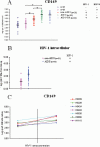Sialoadhesin (CD169) expression in CD14+ cells is upregulated early after HIV-1 infection and increases during disease progression
- PMID: 17330143
- PMCID: PMC1804103
- DOI: 10.1371/journal.pone.0000257
Sialoadhesin (CD169) expression in CD14+ cells is upregulated early after HIV-1 infection and increases during disease progression
Abstract
Background: Sialoadhesin (CD169, siglec-1 or Sn) is an activation marker seen on macrophages in chronic inflammatory diseases and in tumours, and on subsets of tissue macrophages. CD169 is highly expressed by macrophages present in AIDS-related Kaposi's sarcoma lesions. It is also increased on blood monocytes of HIV-1 infected patients with a high viral load despite antiretroviral treatment.
Methodology/principal findings: We investigated expression of sialoadhesin in untreated HIV-1 and HHV-8 infected patients, by real-time PCR and FACS analysis to establish its expression in relation to infection and disease progression. Patients analysed were either HIV-1 seroconverters (n = 7), in the chronic phase of HIV-1 infection (n = 21), or in the AIDS stage (n = 58). Controls were HHV-8 infected, but otherwise healthy individuals (n = 20), and uninfected men having sex with men (n = 24). Sialoadhesin mRNA was significantly elevated after HIV-1, but not HHV-8 infection, and a further increase was seen in AIDS patients. Samples obtained around HIV-1 seroconversion indicated that sialoadhesin levels go up early in infection. FACS analysis of PBMCs showed that sialoadhesin protein was expressed at high levels by approximately 90% of CD14(+) and CD14(+)CD16(+)cells of HIV-1(+) patients with a concomitant 10-fold increase in sialoadhesin protein/cell compared with uninfected controls.
Conclusions/significance: We have shown that sialoadhesin is induced to high levels on CD14(+) cells early after HIV-1 infection in vivo. The phenotype of the cells is maintained during disease progression, suggesting that it could serve as a marker for infection and probably contributes to the severe dysregulation of the immune system seen in AIDS.
Conflict of interest statement
Figures


Similar articles
-
A macrophage marker, Siglec-1, is increased on circulating monocytes in patients with systemic sclerosis and induced by type I interferons and toll-like receptor agonists.Arthritis Rheum. 2007 Mar;56(3):1010-20. doi: 10.1002/art.22382. Arthritis Rheum. 2007. PMID: 17328080
-
Gene expression profile of AIDS-related Kaposi's sarcoma.BMC Cancer. 2003 Mar 18;3:7. doi: 10.1186/1471-2407-3-7. BMC Cancer. 2003. PMID: 12697073 Free PMC article.
-
Sialoadhesin expressed on IFN-induced monocytes binds HIV-1 and enhances infectivity.PLoS One. 2008 Apr 16;3(4):e1967. doi: 10.1371/journal.pone.0001967. PLoS One. 2008. PMID: 18414664 Free PMC article.
-
Molecular biological assessment methods and understanding the course of the HIV infection.APMIS Suppl. 2003;(114):1-37. APMIS Suppl. 2003. PMID: 14626050 Review.
-
Exploring CD169+ Macrophages as Key Targets for Vaccination and Therapeutic Interventions.Vaccines (Basel). 2025 Mar 20;13(3):330. doi: 10.3390/vaccines13030330. Vaccines (Basel). 2025. PMID: 40266235 Free PMC article. Review.
Cited by
-
Similarities and Differences in the Acute-Phase Response to SARS-CoV-2 in Rhesus Macaques and African Green Monkeys.Front Immunol. 2021 Oct 6;12:754642. doi: 10.3389/fimmu.2021.754642. eCollection 2021. Front Immunol. 2021. PMID: 34691074 Free PMC article.
-
Increased Expression of CD169 on Blood Monocytes and Its Regulation by Virus and CD8 T Cells in Macaque Models of HIV Infection and AIDS.AIDS Res Hum Retroviruses. 2015 Jul;31(7):696-706. doi: 10.1089/AID.2015.0003. Epub 2015 May 11. AIDS Res Hum Retroviruses. 2015. PMID: 25891017 Free PMC article.
-
A New Easy-to-Perform Flow Cytometry Assay for Determining Bacterial- and Viral-Infection-Induced Polymorphonuclear Neutrophil and Monocyte Membrane Marker Modulation in Febrile Patients.Int J Mol Sci. 2024 Oct 29;25(21):11632. doi: 10.3390/ijms252111632. Int J Mol Sci. 2024. PMID: 39519183 Free PMC article.
-
Identification of therapeutic targets and prognostic biomarkers in the Siglec family of genes in tumor immune microenvironment of sarcoma.Sci Rep. 2024 Jan 5;14(1):577. doi: 10.1038/s41598-023-50758-1. Sci Rep. 2024. PMID: 38182638 Free PMC article.
-
Antiretroviral therapy down-regulates innate antiviral response genes in patients with AIDS in sub-saharan Africa.J Acquir Immune Defic Syndr. 2010 Dec;55(4):428-38. doi: 10.1097/QAI.0b013e3181ef4963. J Acquir Immune Defic Syndr. 2010. PMID: 20838227 Free PMC article.
References
-
- Decrion AZ, Dichamp I, Varin A, Herbein G. HIV and inflammation. Curr HIV Res. 2005;3:243–259. - PubMed
-
- Hartnell A, Steel J, Turley H, Jones M, Jackson DG, et al. Characterization of human sialoadhesin, a sialic acid binding receptor expressed by resident and inflammatory macrophage populations. Blood. 2001;97:288–296. - PubMed
-
- Pulliam L, Sun B, Rempel H. Invasive chronic inflammatory monocyte phenotype in subjects with high HIV-1 viral load. J Neuroimmunol. 2004;157:93–98. - PubMed
-
- Kirchberger S, Majdic O, Steinberger P, Bluml S, Pfistershammer K, et al. Human rhinoviruses inhibit the accessory function of dendritic cells by inducing sialoadhesin and B7-H1 expression. J Immunol. 2005;175:1145–1152. - PubMed
MeSH terms
Substances
LinkOut - more resources
Full Text Sources
Medical
Research Materials

